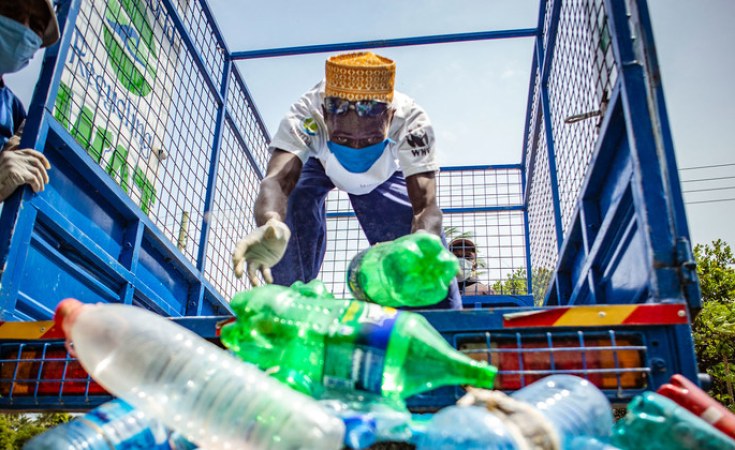Sustainable solutions and alternatives to halt the proliferation of plastic
We need to talk about plastics. Plastic products have become a convenient tool in many areas of life, and agriculture is no different. Plastics are used for everything from seedling trays and irrigation tubing to pesticide containers and livestock feed bags. However, their proliferation has led to mounting environmental problems that threaten soil health, water quality and human well-being.
In late 2021, the Food and Agriculture Organization of the United Nations (FAO) released a landmark report assessing the use of plastics in agriculture. The report calculated that, in 2019, agricultural value chains used 12.5 million tonnes of plastic products in plant and animal production and 37.3 million tonnes in food packaging.
"We estimated that crop production and livestock sectors together contributed 10 million tonnes, followed by fisheries and aquaculture with 2.1 million tonnes and forestry with 0.2 million tonnes," said Richard Thompson, FAO Agricultural Plastics and Sustainability Specialist and one of the authors of the report.
"The global demand for greenhouse, mulching and silage films is also projected to increase by about 50 percent by 2030," he added.
The afterlife of agricultural plastics
But where does all this plastic go once it has served its purpose? Existing data suggests that only a small fraction of agricultural plastics is collected and recycled, while most are buried or landfilled, resulting in negative impacts to ecosystems, biodiversity and human health.
Alarmingly, many plastics aren't disposed of at all. A good example is mulching films, which farmers commonly use to cover the soil to help regulate temperature, conserve moisture and suppress weed growth. These films can be difficult to retrieve after harvesting, often leaving plastic residues in the soil that lead to erosion, reduced water infiltration and decreased microbial activity.
Abandoned plastics have a tendency to degrade into smaller particles known as microplastics. Microplastics can accumulate in the soil and harm beneficial organisms, such as earthworms and mycorrhizal fungi, which are essential for healthy soils and plant growth. They can also transfer and accumulate in food chains, threatening food safety, food security and potentially human health.
"We need to better monitor the quantities of plastic products that are used and that leak into the environment and to promote more responsible models in agriculture, such as the sustainable and circular bioeconomy," according to Lev Neretin, FAO leader of the Bioeconomy for Sustainable Food and Agriculture programme.
Bioeconomy potential
Sustainable and circular bioeconomy -- built on responsible and efficient use of renewable biological resources such as plants, algae, fungi and bacteria -- offers promising solutions to improve the sustainability of plastics used in agriculture.
Upstream, this could be as simple as removing plastics in some cases, for instance using cover crops and plant residues such as straw instead of plastic mulches. But it could also mean using bio-based plastics, which are fully or partially made from biological resources. Bio-based plastics can be less toxic and have a lower environmental and carbon footprint than their petroleum-based equivalents. However, some issues remain with the cost, waste separation, biodegradability and compostability of bio-based plastics.
That is why biodegradable and compostable options -- those that can be broken down by naturally occurring microorganisms such as bacteria and fungi -- are still recommended for some agricultural systems and fishing operations, especially where plastics cannot be avoided in the first place, cannot be replaced with reusable or more durable materials and cannot be easily retrieved.
Looking further downstream, bioremediation -- in which living organisms such as plants and bacteria are used to reduce contamination from microplastics and other pollutants -- is an innovative example of a promising bioeconomy application that can help us tackle pollution. Several studies have confirmed that some microorganisms and plants can remove micro- and nano-plastics from soil or water.
What FAO is doing
Given that much plastic waste can be attributed to agrifood systems, FAO is increasingly designing solutions and supporting governments in sustainably managing agricultural plastics. A good example is the "Financing Agrochemical Reduction and Management" (GEF FARM) project, funded by the Global Environment Facility, through which FAO is supporting Kenya and Uruguay to strengthen their enabling policies and regulatory frameworks to reduce and improve management of agrochemicals and plastics used in agriculture.
In fisheries, the GloLitter Partnerships programme, which FAO is co-leading with Norway and the International Maritime Organization, assists developing countries, including Small Islands Developing States (SIDS) and Least Developed Countries (LDCs), in identifying opportunities for the prevention and reduction of marine litter. The programme is supporting capacity building; policy and institutional reforms; port waste management measures; prevention of dumping of fishing gear; and scaling up of public-private partnerships and best practices.
On the horizon
With plastics high on the environmental agenda, FAO is now supporting countries in the ongoing deliberations of the Intergovernmental Negotiating Committee to develop a legally binding treaty to end plastic pollution. FAO is also taking the global lead to develop a new Voluntary Code of Conduct on the sustainable use of plastics in agriculture.
Meanwhile, the rest of us can play our part too. There are plenty of innovative and creative solutions for tackling plastic pollution and its impacts on human and environmental health. Together, let's beat plastic pollution!


